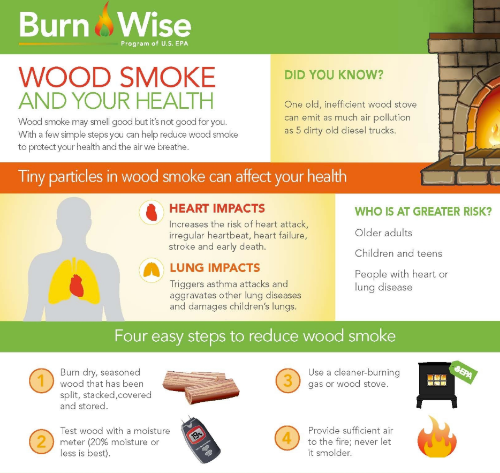Contact
Associate Professor of Air Quality
Phone: (479) 575-4862
Fax: (479) 575-2846
Email: yliang@uark.edu
Firewood and Indoor Air Quality Health Risks
Weatherize Your Home to Save Money
Since wood is cheap fuel, home owners may not consider energy conservation or better insulation as economical. However, insulation and weatherization go a long way, no matter what fuel you choose to heat your homes. Check out Energy saver 101 for more resources.
Reduce Your Health Risk from Burning Firewood
If you do choose to use firewood to heat your home be aware that like any fuel, wood has its drawbacks, among them possible harmful emissions.
The most important pollutants of burning firewood are particulate matter (PM), soot or black carbon, potentially carcinogenic compounds. In addition, wood burning generates nitrogen oxide and carbon monoxide.
Wood combustion contributes to both indoor and outdoor air pollution. Known as PM2.5, fine particulate matter is smaller than 2.5 micrometers (µm) in size. Its small size allows the pollutants to penetrate into the deep lungs.
What are the symptoms of particulate matter exposure?
Short-term exposure to small particulate matter leads to coughing, sneezing, runny nose, and irritation in the eyes, nose, throat, and lungs, and can have serious health effects in people with asthma, heart disease, or other underlying health issues.
Long-term exposure can lead to asthma, chronic bronchitis, reduced lung function, increased cancer risk, reduced immune function, and heart disease, and has adverse effects on the physical development of young children. 80-90% of the dust from wood burning has grain size range below 1 µm.
Soot from wood burning is considered to be as harmful to health as soot from diesel engines.
Carbon monoxide (CO), resulted from incomplete combustion, is a toxic gas that can cause sudden illness and death.
Carbon monoxide combines reversibly with the oxygen-carrying sites on the hemoglobin molecule with an affinity 200 times greater than that of oxygen. The CO-bound hemoglobin molecules accumulate as exposure to carbon monoxide continues. Because of this, fewer hemoglobin particles are available to bind and deliver oxygen, thus causing damage of organ tissues and resulting in death. At low concentrations, CO causes exhaustion, chest pains, and nausea, with symptoms mimic other illness.
What are the symptoms of carbon monoxide pollution?
High concentrations of CO lead to:
- headaches
- impaired vision and coordination
- mental disorder
Exposure can be deadly.
Each year carbon monoxide from household appliances, including wood stoves and other types of heaters, kills roughly 500 people and sends another 15,000 to emergency rooms in the United States. Among the total unintentional carbon monoxide poisoning, the highest number of deaths occurred in winter months each year.
How can I protect my health?
- To protect you and the family from CO poisoning, purchase a CO detector in addition to the smoke detector.
- Be sure that your carbon monoxide detectors meet Underwriters Laboratories (UL) safety standards and that you place them where you can hear while sleeping (usually this will be near bedrooms).
- Bring in a professional chimney sweep for an annual inspection and cleaning of your chimney to ensure no clogging, blockage or damage puts your family at risk.
- Wood heaters manufactured before 1990 tend to burn wood less efficiently, and waste fuel, pollute outdoor air and create dust in your home. Replacing an old wood heater or fireplace with a more energy efficient appliance can save fuel, money, and protect you and your family's health.
Get wood-burning appliance resources
